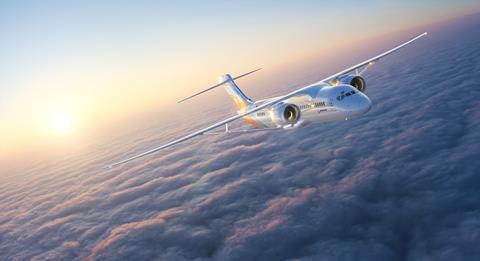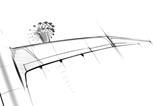Boeing has disclosed fresh details on the progress of the X-66A truss-braced-wing demonstrator it is developing under a NASA-backed project, including confirmation that the aircraft will be powered by a derivative of the Pratt & Whitney PW1500G engine designated the PW102XG.
In January this year, Boeing began the process of transforming an MD-90 airframe into the X-66A, which aims to prove that the Transonic Truss-Braced Wing concept can contribute significant improvements in fuel burn for a next-generation narrowbody.

Boeing chief technology officer Todd Citron, speaking at the ILA Berlin air show on 5 June, said the project was tracking towards a first flight in 2028.
“We have started disassembling the [MD-90] aircraft in preparation for modification. We are already doing testing on the configuration and finalising detailed design of how that modification will be accomplished,” he says.
Boeing’s plans call for the removal of the MD-90’s wing and 19 fuselage sections to permit the installation of the truss-braced-wing structure.
In response to questions from FlightGlobal, the airframer says that “initial aircraft induction activities are complete”, including “engine removal, fairing removal, targeted systems removal in the fuselage, and wing preparation for removal”.
However, it declines to confirm when the detailed design activity will be complete, save to say that “We’re on track for first flight in 2028.”
Flight testing is due to run until 2029. Boeing does not detail how many hours it hopes to accumulate, but adds: “The flight-test programme is being finalised along with the design.”
At the heart of the project is a long, slender wing with a high aspect ratio which will offer better aerodynamic performance than traditional designs but requires the support of a truss linking to the lower fuselage; that structure will itself contribute around 10% of the aircraft’s total lift, Boeing says.
P&W has been selected to supply geared turbofan (GTF) engines for the demonstrator, although exact details on the powerplants to be used are still scarce. Initial plans called for the X-66A to be equipped with PW1100Gs – used for the Airbus A320neo – but this has now switched on the back of weight and drag concerns to what Boeing calls the “PW102XG” which is “a derivative of the PW1500G/1900G series”.
The PW1500G powers the A220, while the PW1900G equips the Embraer EJet-E2 series. While the PW1100G boasts a fan diameter of 81in (206cm), the PW1500G and PW1900G are smaller at 73in.
“The GTF engines for the X-66 programme are a derivative of the 24,000lb-thrust-class although they have a unique designation: PW102XG,” says P&W parent RTX.
“The ‘X’ is a placeholder for the final thrust rating which will be specified by Boeing. We do not plan significant modifications to the propulsion system.”
Geometry of the engines and their nacelles – to be provided by P&W’s sister company Collins Aerospace – has been supplied to Boeing in support of windtunnel testing. Results from this process will be used to “help validate the system concept and inform design of any potential minor modifications to the aircraft design if required”.
“RTX does not plan significant modifications to the propulsion system but will validate performance and operating limits to enable Boeing to set the aircraft’s operating envelope,” the company adds.
The truss-braced-wing concept could support a next-generation narrowbody aircraft for service entry in the 2030s. While current engine options are broadly similar conventional turbofan designs, that seems likely to change in future as the industry targets a step-change in efficiency and environmental performance.
While P&W is pursuing concepts based on its GTF engine, narrowbody propulsion rival CFM International is developing an open-rotor demonstrator under the RISE programme.
Although Boeing says there are “no plans currently to install any type of ‘open-fan’ propulsion system” on the X-66A, it notes that the “high-wing geometry… would allow for a future installation of such a propulsion system”.































